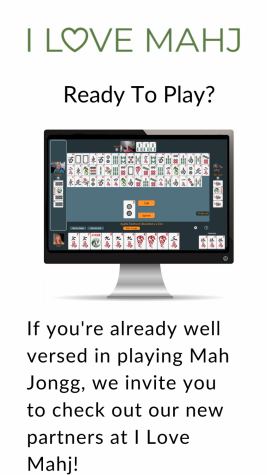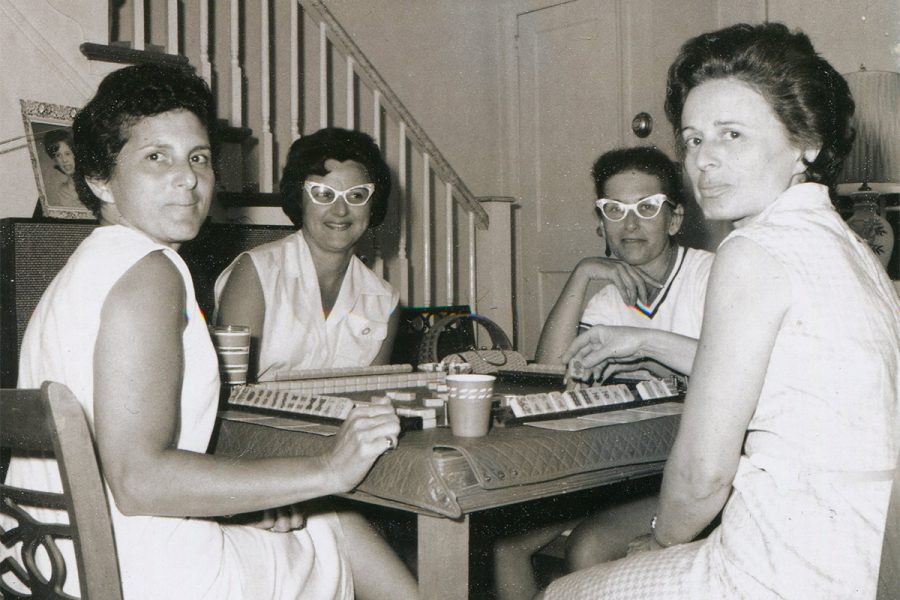This Week In Mah Jongg: Understanding the Card
Published April 10, 2023
Welcome to the next installment of our Beginner’s Guide to this wonderful game presented by I Love Mahj! Last week you were introduced to the 152 tiles that make up an American Mah Jongg set. This week we’ll focus on the Official Standard Hands and Rules card. If you have questions about the game, please email them to [email protected].
 Follow I Love Mahj on Facebook Follow I Love Mahj on Instagram
Follow I Love Mahj on Facebook Follow I Love Mahj on Instagram
American Mah Jongg uses a card that lists the winning combinations of tiles (called “hands”). The goal of the game is to be the first player at your table to match all 14 tiles with one of these combinations. As we discussed last week, the most widely played card is produced by the National Mah Jongg League (NMJL) and is available to purchase in their store. The cost is $9-$10, depending on the size selected.
Having a card adds an interesting twist to the game since players need to know it well enough to be able to quickly pattern-match with the tiles they’re dealt. To keep players on their toes, a new card is published every year, around March/April! So, just when you think you’ve memorized and mastered the card, you have to start over and learn a new one!
Unfortunately, we cannot show you the card due to copyright restrictions so you’ll need to purchase your own. However, we’ll teach you how to read the card, so you can understand which tile combinations are valid.
Hands
Each line on the card represents a winning hand and each hand is made up of 14 tiles. The hands are depicted in 1, 2 or 3 colors, which indicate the number of suits required. You may recall from last week’s post that there are 3 suits – cracks, bams and dots. Notes after each hand help specifically define each.
Abbreviations
The following abbreviations are used:
- 1 – 9 : numbered tiles in each suit
- D: dragon
- F: flower
- N, E, W, S: North, East, West & South winds
- 0: soap (white dragon) – when it is being used as a zero in a year hand
Combinations
A given hand is broken into groups of identical tiles:
- Single: 1 single tile
- Pair: 2 identical tiles
- Pung: 3 identical tiles
- Kong: 4 identical tiles
- Quint: 5 identical tiles
- Sextet: 6 identical tiles
For instance:
- A pung of East winds will be represented as EEE
- A kong of 5s will be represented as 5555
- A quint of flowers will be represented as FFFFF
Note that these are combinations of identical tiles only. The card also includes groups of tiles that are represented together, but since they are made up of different tiles, they should really be considered as individual tiles (singles). For example, NEWS is not a kong but a set of 4 different wind tiles (4 single tiles). Similarly, a year hand (eg: 2021) is a set of 4 single tiles. This often confuses beginners, but just remember that tiles must be identical to be considered a group of 2, 3, 4, 5 or 6 tiles (pair, pung, kong, quint or sextet).
Colors
Three colors are used on the card: blue, green, and red. These colors do not represent any particular suit. Instead, each color can represent any one suit. Within a given hand on the card, all tiles depicted in the same color should be in the same suit.
In the example above, the 2s and 4s need to be in the same suit, and the 6s and 8s need to be in another suit. For instance, your 2s and 4s could be dots and your 6s and 8s cracks; or your 2s and 4s could be bams and your 6s and 8s dots – these examples are depicted below:
So, whichever suit you choose for your 2s and 4s, the 6s and 8s can be in either of the other two suits. Obviously, there are many more combinations than the two shown above.
When dragons are included in a combination and they are marked in the same color as the rest of the hand, they need to match the suit used:
- Green Dragons with Bams
- Red Dragons with Cracks
- White Dragons (Soap) with Dots
In this example, the hand is marked in one color (blue), so all tiles must be in the same suit. Therefore, the dragons must match the suit chosen. For instance, a winning hand could be a pair of 2-cracks, a pung of 4-cracks, a kong of red dragons (the dragons that match cracks), a pung of six-cracks and a pair of 8-cracks, as follows:
In some hands, the dragon is depicted in a different color to the other tiles, indicating it should NOT match the other suits being used (this is called “opposite dragon”).
For the example above, we will need to use one suit for the 2s and 4s, another suit for 6s and 8s and dragons should match the 3rd suit. For instance, a winning hand could be a pair of 2-dots, a pair of 4-dots, a pung of 6-cracks, a pung of 8-cracks and a kong of green dragons (which match the 3rd suit, bams), as follows:
Sections
The hands on the card are grouped in sections, which are mostly consistent from year to year, as follows:
- <year>: include the current year expressed with numbered tiles and soaps for zeros
- 2468: even numbers only
- Any Like Numbers: all numbers are the same (eg: all 2s).
- Quints: as the name implies, these hands include quints (5-of-a-kind)
- Consecutive Run: various patterns of sequential numbers (eg: 5, 6, 7, 8, 9)
- 13579: odd numbers only
- Winds and Dragons: mostly winds and dragons (though some hands include numbers)
- 369: hands that include the numbers 3, 6 and 9 only
- Singles and Pairs: only single tiles and pairs of tiles (no other groupings)
- Some cards also include a section based on multiplications or additions
(eg: FFFF 5555 x 3333 = 15)
Notes:
- In each section, a hand may also include dragons and/or flowers
- For Any Like Numbers, the numbers are represented as 1s, but can be any number.
- In the Consecutive Run section, the numbers are represented starting from 1, but could be any sequence of numbers (unless otherwise indicated in the notes).
For example, FFFF 1111 22 3333, a winning hand could be a kong of flowers, a kong of 4-cracks, a pair of 5-cracks and a kong of 6-cracks, as shown below:
Concealed Hands
Most hands are marked with an X at the end of the row (which means exposed) and others with a C, which denotes a concealed hand. Playing a concealed hand is more difficult, as it’s not possible to call a discarded tile (more on that in a future article). However, the added restrictions allow you to earn extra points if you were to win playing a concealed hand.
Notes
Clarifying notes in parenthesis are included after each hand listed on the card. These notes explain what is actually permitted in order to avoid possible confusion.
For example, line 1 in the Consecutive Run section of the card generally includes the note “These numbers only”. As discussed earlier, it’s generally the case that any sequence of consecutive numbers can be used in this section. However, for this particular line, the note clearly states that only the specific numbers shown on the card are valid.
Another example is FFFFF DDDD 11111. Since the numbers are depicted in a different color to the dragons, it would be usual to assume they have to be in different suits. However, the note might say “Any number, any suit, any dragon”, which means suits are irrelevant in this case. So, be sure to read the notes carefully.
Points
The final piece of information on the card is the number of points available for each hand. This indicates how many points you will receive if you win. It’s also possible to earn bonus points, but we’ll cover this another time.
Whoa, that’s a lot to take in! We know things can seem a little overwhelming at first. No worries, take all the time you need to study the fundamentals, as these will stand you in good stead once you start playing.
Next Week: Playing the Game
Next time we’ll get into the mechanics of the game and you’ll begin to see why so many people love playing Mah Jongg!
In the meantime, we recommend ordering your card, as this will make it easier for you to follow along, and will allow you to start playing and practice what you’ve learned. Also, be sure to send any questions you may have to [email protected]. See you next time!















